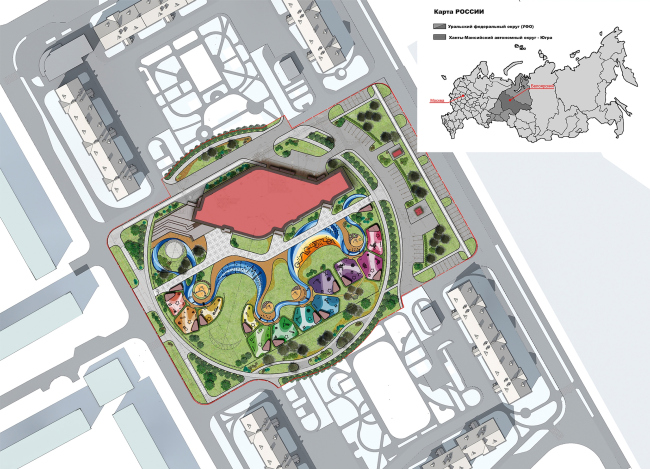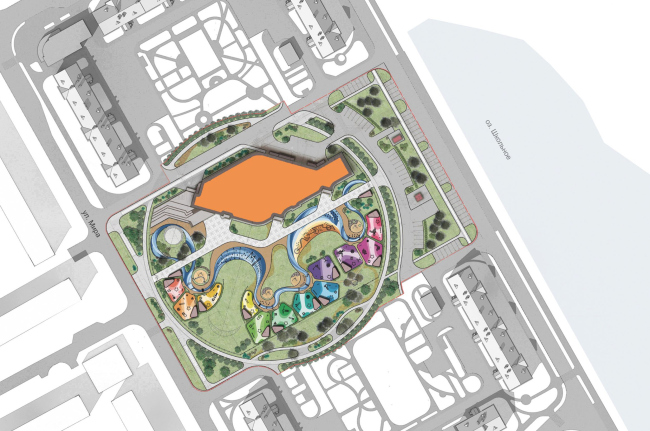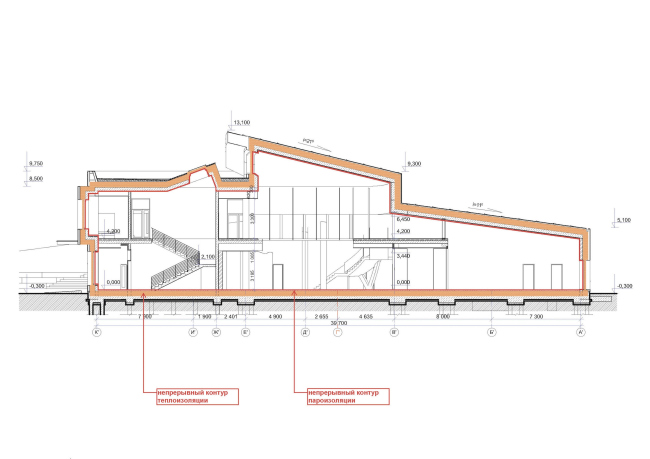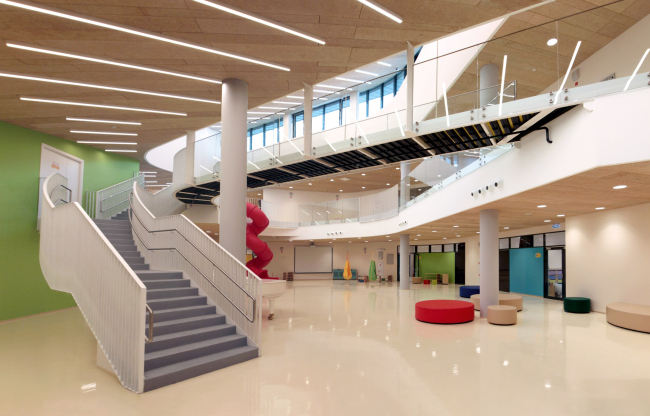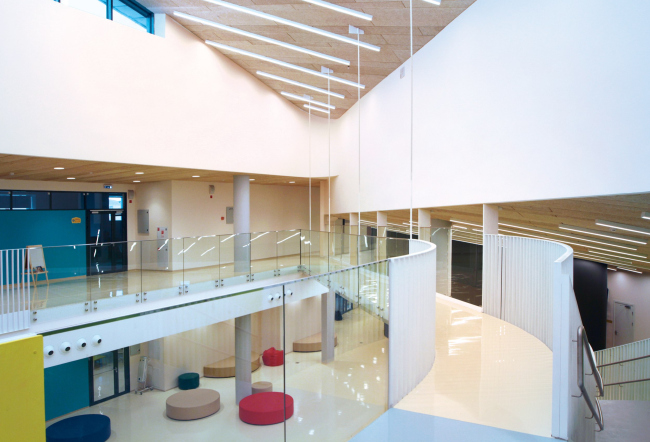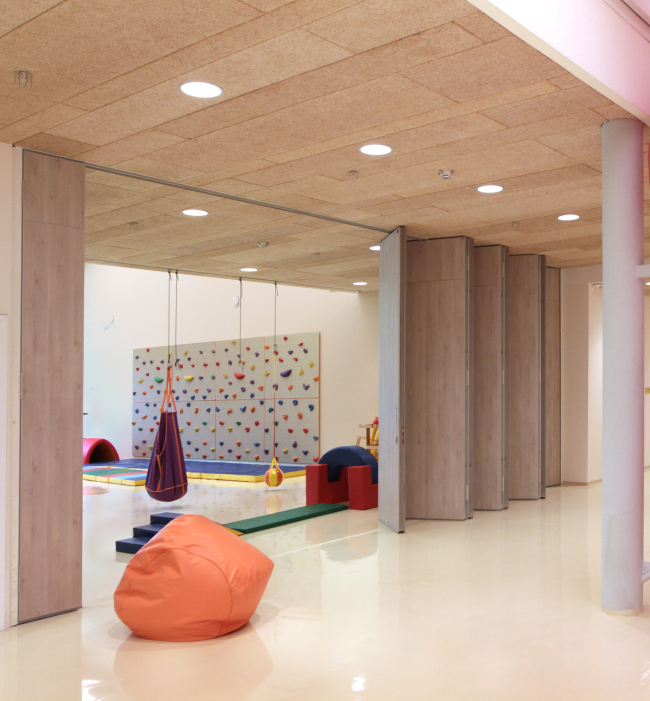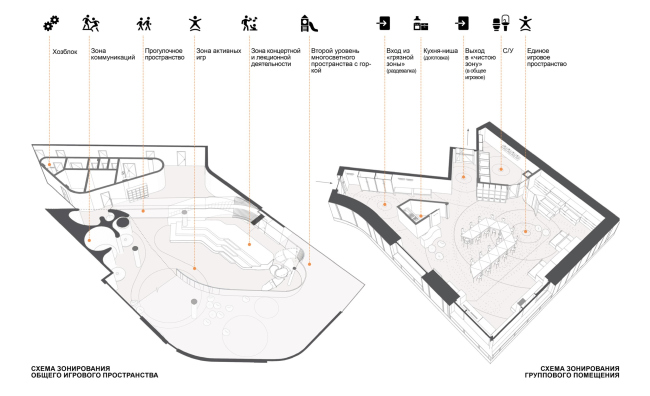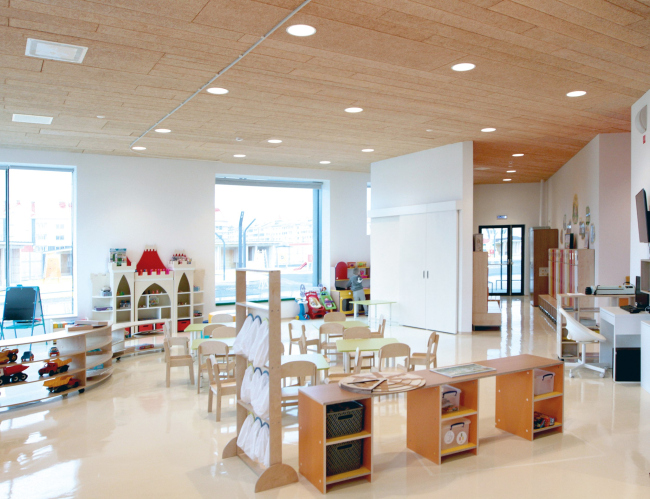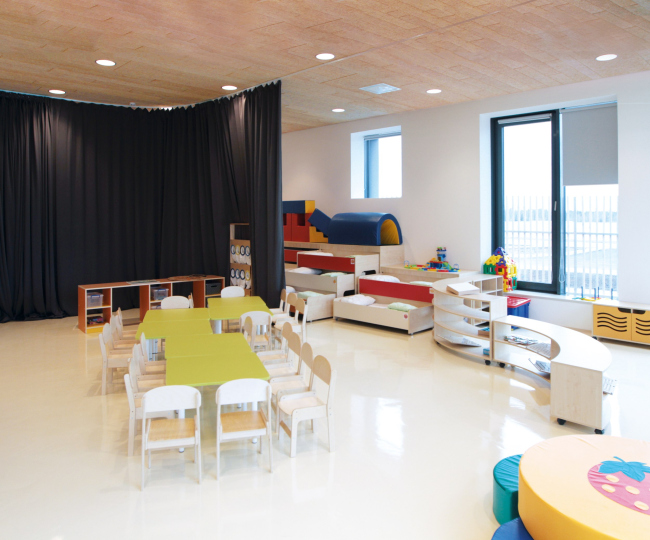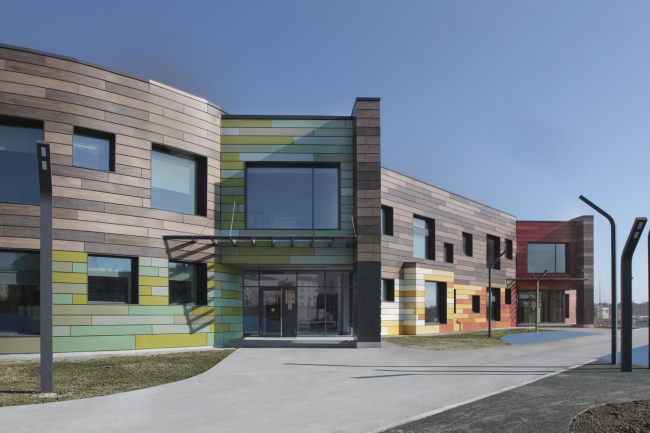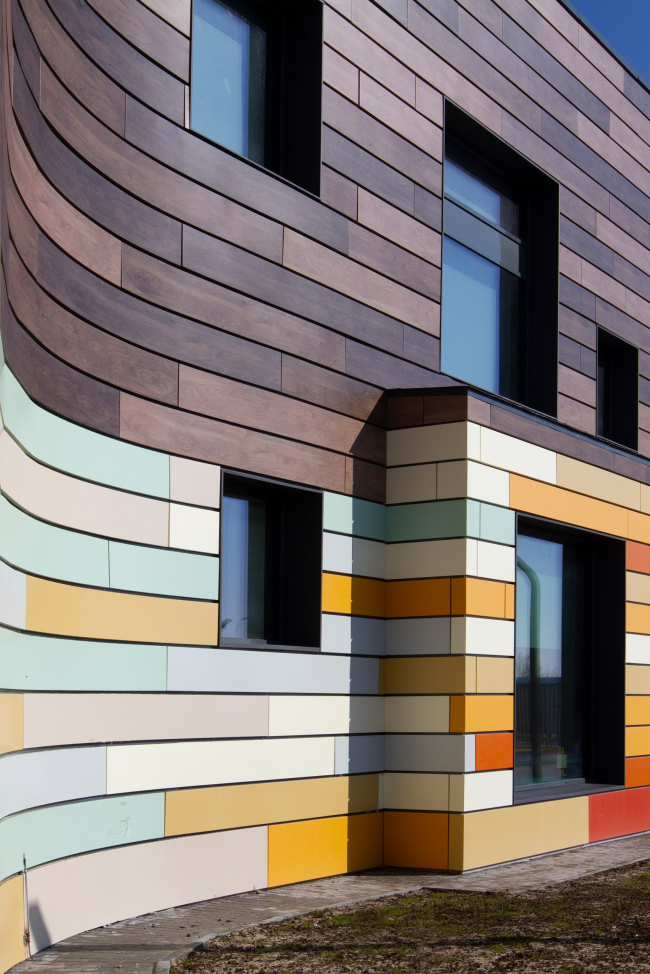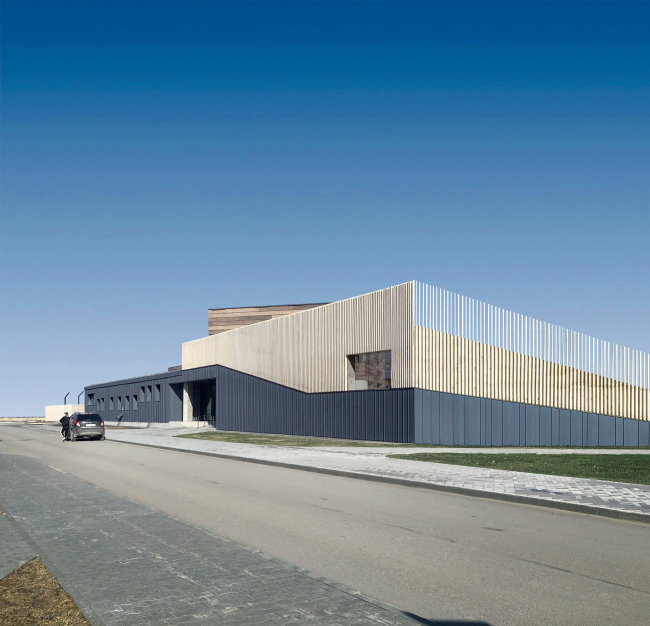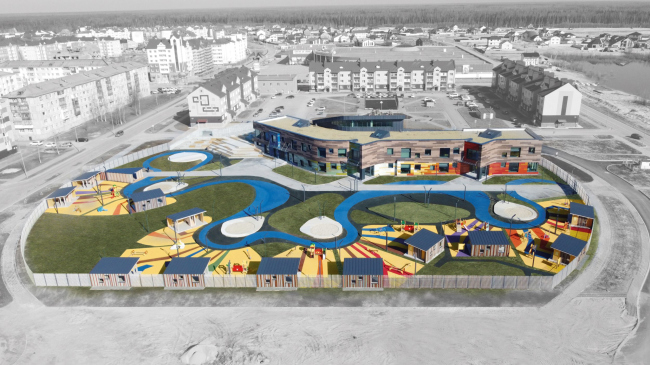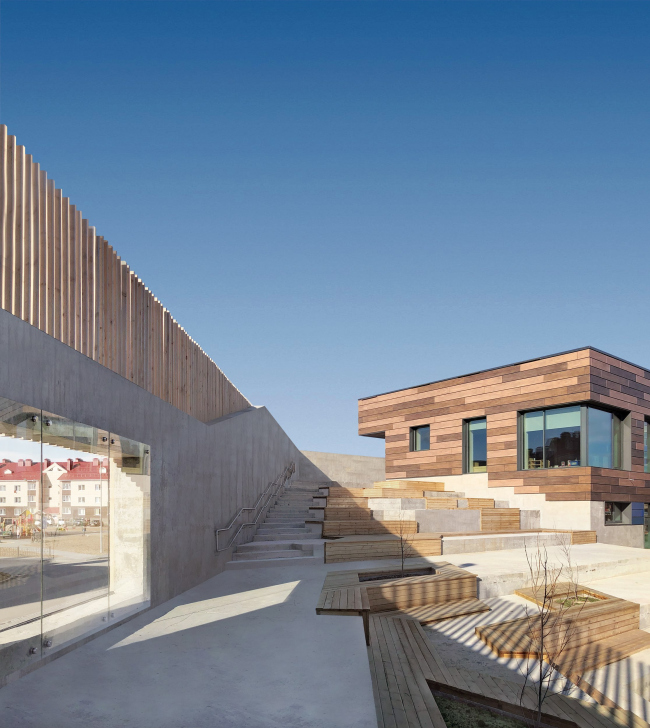|
Published on Archi.ru (https://archi.ru) |
|
| 24.04.2023 | |
|
First among Equals |
|
|
Alla Pavlikova |
|
| Architect: | |
| Anton Lukomsky | |
| Valery Lukomsky | |
| Studio: | |
| City-Arch | |
|
The building of a kindergarten in the town of Beloyarsky is more than just another example of a modern educational space. Its design began a long time ago; it is located in Russia’s Far North; it is also a state-owned facility that is subject to regulations, and had to cut costs during construction (as usual). However, the design is contemporary, the layout is modern, and the building feels very fresh. The project is planned to be replicated.
Kindergarten in Beloyarsky.Copyright: City-ArchAs Anton Lukomsky, the chief architect and managing partner of City-Arch, explained, at the initial stage, the architects closely collaborated with the creators of the educational program “Yugorsky Tramplin”, specially developed for the Khanty-Mansi Autonomous District, as well as thoroughly studied the European and global standards of modern educational facilities, based on the principles of a comprehensive approach to the education and upbringing of children. As a result, an unconventional layout of the kindergarten appeared, which allows children of different ages to communicate with each other. In addition to creating a modern educational environment, the architects faced difficult tasks of optimizing the area and achieving energy efficiency of the building in the conditions of the Far North. The process of project approval and passing it through the expertise was even more complicated, taking into account the strict construction and sanitary norms, most of which were outdated at that time. The struggle against restrictions and bureaucratic processes significantly prolonged the construction process.  Anton Lukomsky, City-Arch To implement this project in collaboration with the Ministry of Construction, the Ministry of Education, and Rospotrebnadzor, it was necessary to make a few amendments to the regulatory framework. Fire safety standards, sanitary norms, and much more were changed. As a result, we were still able to pass the examination and practically implement a federally owned project with limited budget, which was ordered by the Department of Education of the Khanty-Mansi Autonomous District. If the task set before the architects, which was to design a kindergarten based on modern pedagogical principles, could be understood as a conceptual challenge, then the location became a challenge in its own right in terms of natural geography. The building is located in a new residential District 3A. The plot is delineated on one side by the Mira Street, and on the other by the large Shkolnoye Lake, which serves as the natural eastern boundary of the city and is part of a vast system of rivers, streams, canals, lakes, and swamps – there are about a thousand of them in the Beloyarsky district. Permafrost here is combined with swampy wetlands, and besides, the city is small and located far from large settlements, and the period of relatively comfortable delivery of building materials is short: the nearest railway station Priobye is 240 km away in winter, and 48 km away in summer if you use a ferry crossing. Kindergarten in Beloyarsky. Master plan. Project, 2014 © City-ArchCopyright: City-ArchKindergarten in Beloyarsky. Location planCopyright: City-ArchAnd yet, if the design and approval took six years, then the construction was carried out quickly and took approximately one year – work began in 2020, and in early May 2021, the grand opening took place. “It turned out that all European methods for building a kindergarten in such a harsh climate do not work – said Anton Lukomsky, chief architect and managing partner of City-Arch – Therefore, in order to achieve good energy efficiency performance, we had to conduct a kind of scientific work, which involves serious analysis and energy modeling.” The authors based the design of the building on the concept of a passive house, which includes efficient orientation with respect to the cardinal points. The building is placed in the northern part of the site, which is calm and flat without any elevation changes. This allows the illuminated southern side to be maximally cleared for sports fields and playgrounds. Kindergarten in Beloyarsky.Copyright: City-ArchIn terms of structure, two main volumes can be identified that form the building: a stretched two-story block with classrooms, oriented southward, and an adjacent diamond-shaped block with a sloping roof, located in the north. The roof height decreases from the south to the north, protecting the volume from cold winds. Under its slope, there are music and sports halls, a swimming pool, a medical office, a food block with a kitchen equipped with a separate entrance and loading area, as well as technical, domestic, and administrative rooms. That is, everything that does not require a large amount of light and can generally get by with a minimal amount of windows to retain heat. At the same time, on the south side, the windows are large, square, with triple-glazed units, capturing maximum sunlight and, in terms of their heat engineering, are virtually as effective as the walls covered with 400 mm thick mineral wool insulation. During the short but sunny summer in Beloyarask, the same windows protect the rooms from overheating due to special multifunctional spraying. The building is also protected from heat loss by a massive airtight shell with a closed thermal perimeter without “cold bridges” and a well-insulated foundation and roof. The thermal contour of the foundation, which protects against permafrost melting, allowed the volume not to be raised above the ground on supports. Kindergarten in Beloyarsky. Plan of implementing the new warming principle. Project, 2014 © City-ArchCopyright: City-ArchKindergarten in Beloyarsky. Passive House Institute (PHI) concept. Project, 2014 © City-ArchCopyright: City-ArchThe junction of the two main volumes of the building is the highest point. Here, the architects have placed a large double-height play area, which became the main innovation of the project, opposing the traditional corridor system and the principle of isolated classrooms. The latter is still considered a mandatory condition for the construction of any Russian kindergarten. In Beloyarsk, however, according to the architects’ concept, children of all ages have the opportunity to communicate and play with each other. They spend about two hours a day in the common play area – before breakfast, when they are first brought to the kindergarten, and after dinner, when the little ones are waiting for their parents. In addition, the play area is an excellent place for holding holidays and events, in which all children can participate together, rather than separate groups, as is customary in most kindergartens. And this is also a great opportunity for communication. Kindergarten in Beloyarsky. The central game spaceCopyright: City-ArchKindergarten in Beloyarsky. The central game spaceCopyright: City-ArchThe central communication core with designated soft resting zones gathers around itself all the rooms of the kindergarten. Group rooms, classrooms, and a swimming pool open onto it. It is overlooked by the bypass galleries of the second floor, connected to the first floor by a staircase and a spiral slide. Transformable partitions connect the play area with the sports and music halls. Kindergarten in Beloyarsky. The gymCopyright: City-ArchKindergarten in Beloyarsky. The pull-out partitionsCopyright: City-ArchThe proposed layout, in which not only corridors but also a basement level are absent, allowed, among other things, to reduce the total area of the building to 14.7 m² per child, which means reducing heating costs. At the same time, the play area for one child has increased by more than four times. Kindergarten in Beloyarsky. The functional diagramCopyright: City-ArchKindergarten in Beloyarsky. The planning specificsCopyright: City-ArchOn the first floor, there are classrooms for younger children, while the second floor is for older ones, with the possibility of transforming them into elementary school classrooms. The group rooms in the Beloyarsk kindergarten are designed as a single space that is zoned with the help of soft sliding partitions and transformable furniture. Using partitions during quiet hours, a sleeping area is made, and sliding triple bunk beds are used for sleep. At other times, the entire area of the room, including the changing rooms, is used for games and activities. Kindergarten in Beloyarsky. The group premisesCopyright: City-ArchKindergarten in Beloyarsky. The group premisesCopyright: City-ArchThere was no specific order to work on the interior design of the group rooms, but the architects from City-Arch, as is often the case, took responsibility for it, offering recommendations on space organization, color codes, and selecting convenient, lightweight, and transformable furniture. However, the specific features of these interiors were largely predetermined by the architecture of the building, with varying-sized square windows, some of which are located almost at the ceiling, while others are slightly above the floor level, allowing children to observe what is happening outside. Kindergarten in BeloyarskyCopyright: City-ArchThe facades were initially supposed to be faced with porcelain stoneware with a wood texture, but due to budget constraints, preference was given to aluminum cassettes. And to maintain the architectural image proposed in the project, the manufacturer specially executed color printing under the wood on the aluminum surface for the Beloyarsky kindergarten. This was a kind of experiment. The first floor, also made of metal cassettes, turned out to be brighter. Three entrance areas on the south side, allowing children to find their group without error, were highlighted in color. Kindergarten in BeloyarskyCopyright: City-ArchKindergarten in BeloyarskyCopyright: City-ArchKindergarten in Beloyarsky. The north facadeCopyright: City-ArchThe architects also experimented with the territory of the kindergarten. Despite the regulation standards, it is inevitably surrounded by a fence, yet the kindergarten yard became an important accent for the entire residential area. The paving of the paths resembles the winding rivers of the Beloyarsky district, and in addition to separate playgrounds, a common “mini-square” is provided, which serves as a communication hub, similar to the common play area inside the building. Kindergarten in Beloyarsky. The landscapingCopyright: City-ArchPart of the sloping roof of the building was planned to be turned into a slide, but this idea was later abandoned in favor of an amphitheater in the western part of the second floor level; however, in winter, children do use it as a slide. Kindergarten in Beloyarsky. The amphitheaterCopyright: City-ArchThe kindergarten in Beloyarysk is an example of a high-quality educational space designed for comfortable communication between children. There are more and more such examples today, and such new schools and kindergartens are widely discussed. Another interesting thing about the Beloyarsk kindergarten is that, first of all, it admits children of a very young age, secondly, it is not state-owned, and finally, it was built very far away and in very difficult conditions, and very quickly too. It represents an example of architects’ persistent struggle for the values of the modern world: openness, communication, light, and beauty. All of this is achievable and implementable if you set the task and put your heart into it. Currently, there is a discussion about the idea of replicating the project in other areas of the Khanty-Mansi Autonomous District. |
|

